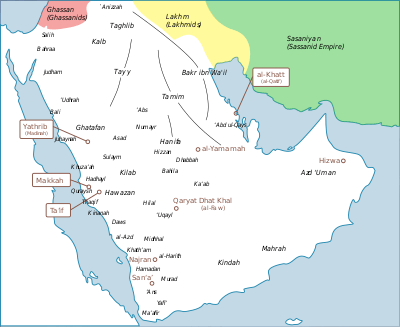Banu Kinanah
The Banu Kinanah (Arabic: بَنُو كِنَاَنَة, romanized: Banū Kinānah), also spelled Bani Kināna, are the largest Mudhari Adnanite tribe in the Hejaz and Tihama regions of western Saudi Arabia. Their original territory was located near the city of Mecca.[1] A number of modern-day tribes throughout the Arab world trace their lineage to the Banu Kinanah.[2]
| Banū Kīnânah بَنُو كِنَاَنَة | |
|---|---|
| Adnanite Arabs | |
.png) Banner of the Banu Kinanah | |
| Nisba | Al-Kīnânī الْكِنَانِيّ |
| Location | Arabian Peninsula and Arab World |
| Branches | Quraysh |
| Religion | Islam |
Geography
They live mainly in Western Arabia (western part of Saudi Arabia) called the Hedjaz region; some clans of their tribes live mainly in Sudan, Algeria, Iraq, Syria, Tunisia, Libya, Morocco, Lebanon, Egypt, Jordan, Palestine and Yemen.
Early history
The tribe traces its ancestry to Ishmael, who married a woman of the Arab Jurhum tribe and settled in the vicinity of Mecca according to Islamic tradition.[3][4] Both the Banu Kinanah themselves and their various branches were polytheists, with their worship centering on the goddess al-Uzza.[5] Islamic tradition holds that the Kinanah and the other descendants of Ishmael gradually dispersed throughout northern Arabia, losing their original faith and falling into idolatry.[4]
Their eponymous ancestor is Kinanah ibn Khuzayma ibn Mudrikah ibn Ilyas. Kinanah ibn Khuzayma was also the ancestor of the people of the Quraysh , including the Islamic prophet Muhammad.[5]
Ibn Ishaq states that the Banu Kinanah and the Quraysh later reclaimed Mecca from the Banu Khuza'a tribe, which had established itself in the city. This led to the Quraysh becoming the custodians of the Kaaba.[5]
Related tribes

The early Islamic historians Ibn Ishaq and Ibn Hisham state that Kinanah ibn Khuzayma had four sons named an-Nathr, Abd-Manāt, Milkan, and Malik. The Quraysh are listed as descendants of an-Nadr.[5] The clans of Banu Thalaba, Banu al-Harith ibn Malik, Banu Firas ibn Ghanm, Banu Mukhdadj ibn Amir, and Banu Fukaim ibn Adl are listed as descendants of Malik.[2] The descendants of Abd-Manat include the tribes of Banu Ghifar, Banu Laith, Banu Bakr ibn Abd Manat, Banu Du'il, Banu al-Harith, Banu Mudlidj, and Banu Damra ibn Bakr. While it is unlikely that these genealogies are historically accurate, they reflect the ties of kinship that these clans perceived to exist between them.[2]
In Islamic history
Islamic historians did not note the actions of the Banu Kinanah as a united tribe in the time of Muhammad, though several of the tribe's offshoots, including the Quraysh, played pivotal roles in the formation and spread of Islam.[2] After the Islamic conquests, some members of the tribe and its branches migrated to the newly-conquered territories, and a number of them were appointed governors of ajnad. In addition to Saudi Arabia, the Banu Kinanah are documented in Palestine and Egypt.[6][7]
See also
References
- Watt, W. Montgomery. "Kinana". Brill. Retrieved 22 October 2018.
- M. Th. Houtsma, ed. (1993). "Kinana". E. J. Brill's First Encyclopaedia of Islam, 1913-1936, Volume 4. pp. 1017–1018. ISBN 9789004097902.
- "Sahih Muslim". Retrieved 22 October 2018.
- Peters, Francis E. Muhammad and the Origins of Islam. pp. 5–15.
- Ibn Ishaq (1955). The Life of Muhammad: A Translation of Ibn Isḥāq’s sīrat. Translated by Alfred Guillaume. London. pp. 3, 38–41, 52–53. ISBN 0195778286.
- Gil, Moshe (1997) [1983]. A History of Palestine, 634–1099. Translated by Ethel Broido. Cambridge: Cambridge University Press. p. 116. ISBN 0-521-59984-9.
- Butler, Alfred J. (1895). The Churches and Monasteries of Egypt. University of Michigan. p. 110.